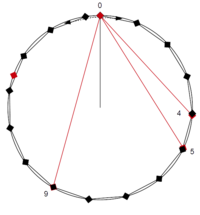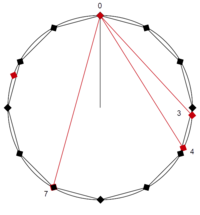
12 TET: 300 cents ⓘ,
Alpha scale: 312 cents ⓘ
The α (alpha) scale is a non- octave-repeating musical scale invented by Wendy Carlos and first used on her album Beauty in the Beast (1986). It is derived from approximating just intervals using multiples of a single interval, but without requiring (as temperaments normally do) an octave (2:1). It may be approximated by dividing the perfect fifth (3:2) into nine equal steps, with frequency ratio [1] or by dividing the minor third (6:5) into four frequency ratio steps of [1] [2] [3]
The size of this scale step may also be precisely derived from using 9:5 (B♭, 1017.60 cents, ⓘ) to approximate the interval 3:2 / 5:4 = 6:5 (E♭, 315.64 cents, ⓘ ). [4]
- Carlos' α (alpha) scale arises from ... taking a value for the scale degree so that nine of them approximate a 3:2 perfect fifth, five of them approximate a 5:4 major third, and four of them approximate a 6:5 minor third. In order to make the approximation as good as possible we minimize the mean square deviation. [4]
The formula below finds the minimum by setting the derivative of the mean square deviation with respect to the scale step size to 0 .
and (
ⓘ)
At 78 cents per step, this totals approximately 15.385 steps per octave, however, more accurately, the alpha scale step is 77.965 cents and there are 15.3915 steps per octave. [4] [5]
Though it does not have a perfect octave, the alpha scale produces "wonderful triads," ( ⓘ and ⓘ) and the beta scale has similar properties but the sevenths are more in tune. [2] However, the alpha scale has
- "excellent harmonic seventh chords ... using the [octave] inversion of 7 / 4 , i.e., 8/7 [ ⓘ]." [1]
| interval name | size (steps) |
size (cents) |
just ratio | just (cents) |
error |
| septimal major second | 3 | 233.89 | 8:7 | 231.17 | +2.72 |
| minor third | 4 | 311.86 | 6:5 | 315.64 | −3.78 |
| major third | 5 | 389.82 | 5:4 | 386.31 | +3.51 |
| perfect fifth | 9 | 701.68 | 3:2 | 701.96 | −0.27 |
| harmonic seventh | octave−3 | 966.11 | 7:4 | 968.83 | −2.72 |
| octave | 15 | 1169.47 | 2:1 | 1200.00 | −30.53 |
| octave | 16 | 1247.44 | 2:1 | 1200.00 | +47.44 |
See also
References
- ^
a
b
c
Carlos, Wendy (1989–1996).
Three asymmetric divisions of the octave (Report).
Archived from the original on 2017-07-12. Retrieved 2010-06-13 – via WendyCarlos.com.
9 steps to the perfect (no kidding) fifth." The alpha scale "splits the minor third exactly in half (also into quarters).
- ^
a
b Milano, Dominic (November 1986).
"A many-colored jungle of exotic tunings" (PDF). Keyboard.
Archived (PDF) from the original on 2010-12-02. Retrieved 2010-06-13 – via wendycarlos.com.
The idea was to split a minor third into two equal parts. Then that was divided again.
- ^ Carlos, Wendy (2000) [1986]. Beauty in the Beast (record liner notes). ESD 81552.
- ^
a
b
c Benson, Dave (2006). Music: A mathematical offering. Cambridge University Press. pp. 232–233.
ISBN
0-521-85387-7.
This actually differs very slightly from Carlos' figure of 15.385 α-scale degrees to the octave. This is obtained by approximating the scale degree to 78.0 cents.
-
^
Sethares, W. (2004). Tuning, Timbre, Spectrum, Scale. Springer. p. 60.
ISBN
1-85233-797-4.
... scale step of 78 cents.






